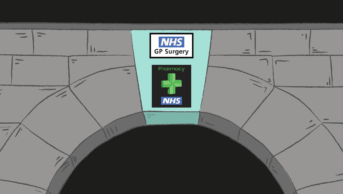
Shutterstock.com
Pharmacies are struggling to provide enough consultations to meet Pharmacy First payment thresholds, despite government interventions, Community Pharmacy England (CPE) has reported.
The Pharmaceutical Journal has been told that half of eligible pharmacies in some parts of England are not meeting the payment threshold.
Board papers published for CPE’s service development subcommittee’s February 2025 meeting said: “Despite… reductions, the minimum threshold has continued to be challenging for many pharmacy owners to meet for multiple reasons.
“For example, a reduction in referrals and increase in signposting from GP practices caused in part by the British Medical Association’s safe working in general practice in England guidance.
“We have continued to raise our concerns about the monthly thresholds with the Department of Health and Social Care and NHS England, and the thresholds in 2025/2026 will be discussed in the now restarted negotiations.”
The threshold is the number of monthly consultations that participating pharmacies must complete to trigger a £1,000 monthly payment.
In February 2024 — the first month of the service — pharmacies had to provide one consultation to qualify for the payment, followed by five consultations in March and April 2024 and ten consultations in May, June and July 2024.
Then, in August 2024, the threshold was due to rise to 20 consultations, but the government reduced the figure to 15 consultations.
The threshold was expected to increase to 30 consultations in October 2024, but NHS England announced on 14 October 2024 it would remain at 20 consultations until December 2024, before being increased to 25 consultations in January and February 2025.
In March 2025, NHS England plans to increase the monthly threshold to 30 consultations.
An analysis of threshold payments by The Pharmaceutical Journal, published in September 2024, showed that pharmacies have missed out on almost £10m in funding since the service launched on 31 January 2024.
Stephen Noble, chief officer of Community Pharmacy Dudley, confirmed the difficulty in hitting the threshold.
“Of the Black Country pharmacies delivering Pharmacy First, only 50% are hitting or exceeding the threshold. Even more worryingly, 20% are registering no Pharmacy First activity,” he said.
“We need to investigate this and can hopefully support pharmacies not delivering on Pharmacy First. Another concern is that some contractors don’t seem to realise the three national services have to be delivered together. It’s all-or-nothing, not pick-and-mix.”
Raj Matharu, chief executive of Bexley, Bromley and Greenwich Local Pharmaceutical Committee, said he had seen integrated care board (ICB) figures that suggested around half of contractors would not meet threshold targets in his area.
“Reasons include limited marketing of the service; ongoing confusion around its branding, with many GPs still struggling to understand Pharmacy First; insufficient local promotion by pharmacists; IT systems not fit for purpose; GPs using total triage which works against the Pharmacy First concept; and a lack of responsiveness from the commissioner to concerns raised by GPs and community pharmacists,” he added.
An analysis of Pharmacy First consultations by The Pharmaceutical Journal revealed in October 2024 that the first five months of the service had produced large regional variations in the volume of consultations carried out.
In January 2025, the government said it would be “maximising Pharmacy First approaches” to ear, nose and throat care, as part of plans intended to cut NHS waiting lists.
A spokesperson for NHS England said: “Pharmacy First is giving patients quick, easy access to support for common conditions through their high street pharmacy. We are working closely with ICBs to support pharmacies and GP practices to ensure the right patients can be seen in pharmacy settings, offering a more convenient option for those with minor illness and an opportunity to better manage capacity across primary care.”
1 comment
You must be logged in to post a comment.



It's amazing how there's untapped funding available for pharmacies to provide these services. and the Face to Face pharmacies that can provide all of these services without restriction aren't able to, but distance selling pharmacies are blocked from accessing all of this funding. Maybe the idea was that ALL pharmacies have the ability to offer these services and therefore, the funding would be well used and a larger number of patient population would benefit. NHSengland way too heavily influenced by F2F Pharmacies collective organisations and large corporates.